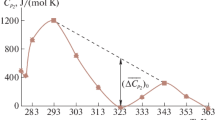Summary
A stable radicalt-butyl-(1,1-dimethylpentyl)-nitroxide was synthesized and solubilized to saturation into a series of sodium dodecyl sulfate (SDS) solutions of increasing concentration. Any solution whose concentration was below the critical micelle concentration (CMC) showed an ESR spectrum composed of a triplet signal, each branch of which formed a narrowLorentzian curve. Above the CMC, the signal shape varied with the change of concentration in a complicated manner, and finally merged into a broaderLorentzian singlet at an extremely high concentration. The spectral change was interpreted in terms of the incessant exchange of radical molecules between micelles and the bulk water phase surrounding micelles. The average stay-time of a radical molecule in a micelle and the mole fraction of micellar radical were determined by comparing experimental spectra with computer-generated theoretical spectra.
As expected, the mole fraction of micellar radical increased monotonically with an increase in SDS concentration. The fact that a definite stay-time (3.3 · 10−6 sec) was obtained at all concentrations exceeding the CMC suggests that an increase in surfactant concentration causes the number of micelles to increase without a notable change in micelle structure.
Zusammenfassung
Ein neues stabiles Radikal,t-Butyl-(1,1-Dimethyl-pentyl)-Nitroxyd wurde synthetisiert und in eine Reihe von Natrium-Dodecylsulfat-Lösungen (NDS-Lösungen) mit zunehmender Konzentration bis zur Sättigung solubilisiert. Jede Lösung, deren Konzentration niedriger als die kritische Mizellkonzentration (CMC) war, zeigte ein Triplet-Signal auf ihrem ESR-Spektrum, wobei jedes eine enge Lorentzsche Kurve bildete. Oberhalb der CMC änderte sich die Gestalt des Signals mit der Konzentration in komplizierter Weise und ging schließlich bei sehr hoher Konzentration in ein Singlet-Signal über. Diese spektralen Veränderungen wurden mit dem Austausch von Radikalmolekülen zwischen Mizellen und der umliegenden Wasserphase gedeutet. Die durchschnittliche Verweilzeit eines Radikalmoleküls in einer Mizelle und die Molfraktion des Radikals in der Mizelle wurden durch Vergleich der experimentellen Spektren mit auf dem Rechner erzeugten theoretischen Spektren bestimmt.
Wie erwartet, nahm die Molfraktion des Radikals in der Mizelle monoton mit steigender NDS-Konzentration zu. Aus der Tatsache, daß eine bestimmte Verweilzeit (3.3 · 10−6sec.) bei allen Konzentrationen oberhalb der KMK erreicht wurde, folgt, daß bei einer Zunahme in der Konzentration eines oberflächenaktiven Stoffes die Zahl der Mizellen zunimmt, ohne daß stärkere Veränderungen im Mizellbau auftreten.
Similar content being viewed by others
References
Nakagawa, T. andK. Tori, Kolloid-Z. u.Z. Polymere194, 143 (1964).
Ohnishi, S., T. J. R. Cyr andH. Fukushima, Bull. Chem. Soc. Japan43, 673 (1970).
Oakes, J., Nature, Friday,231, 38 (1971).
Pople, J. A., W. G. Schneider andH. J. Bernstein, High-resolution Nuclear Magnetic Resonance, p. 218, (New York, 1959).
Tartar, H. V., J. Phys. Chem.59, 11 85 (1955).
Corkill, J. M., J. F. Goodman andT. Walker, Trans. Faraday Soc.63, 768 (1967).
Waggoner, A. S., O. H. Griffith, andC. R. Christensen, Proc. Natl. Acad. U.S.57, 1198 (1967).
Edgar, G., G. Calingaert andR. E. Marker, J. Amer. Chem. Soc.51, 1483 (1929);Whitmore, F. C. andH. M. Woodbourn, ibid.55, 361 (1933);Whitmore, F.C. andJ. M. Church, ibid.55, 1119 (1933);Whitmore, F. C. andD. E. Badertscher, ibid.55, 1559 (1933);Pierotti, G. andT. D. Stewart, ibid.59, 1773 (1937).
Ritter, J. J. andJ. Kalish, J. Amer. Chem. Soc.70, 4048 (1948).
Kornblum, N., R. J. Clutter andW. J. Jones, J. Amer. Chem. Soc.78, 4003 (1956).
Hoffmann, A. K., A. M. Feldman, E. Gelblum, andW. G. Hodgson, J. Amer. Chem. Soc.86, 639 (1964);Hofmann, A. K., A. M. Feldman, E. Gelblum, andA. Henderson, Org. Syntheses48, 62 (1968).
Author information
Authors and Affiliations
Rights and permissions
About this article
Cite this article
Nakagawa, T., Jizomoto, H. Dynamical aspects of solubilization disclosed by analysing ESR spectra of solubilized radicals. Kolloid-Z.u.Z.Polymere 250, 594–601 (1972). https://doi.org/10.1007/BF01501470
Received:
Issue Date:
DOI: https://doi.org/10.1007/BF01501470



